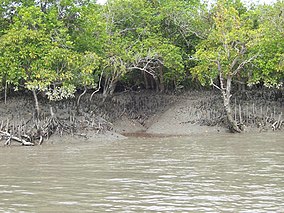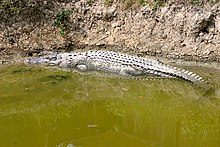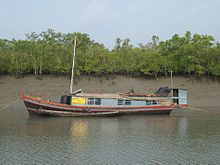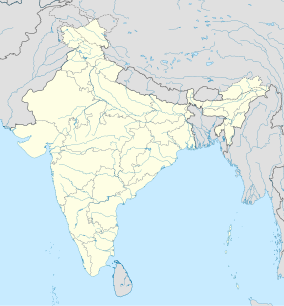Sundarbans National Park: Difference between revisions
mNo edit summary |
|||
| Line 390: | Line 390: | ||
* {{Wikivoyage-inline}} |
* {{Wikivoyage-inline}} |
||
*[http://whc.unesco.org/archive/periodicreporting/APA/cycle01/section2/452.pdf UNESCO Periodic Report] |
*[http://whc.unesco.org/archive/periodicreporting/APA/cycle01/section2/452.pdf UNESCO Periodic Report] |
||
* [http://www.gounesco.com/train-travel-itinerary-world-heritage-sites-india/ Train travel to UNESCO world heritage sites in India] |
|||
{{World Heritage Sites in India}} |
{{World Heritage Sites in India}} |
||
Revision as of 03:53, 7 January 2014
| Sundarbans National Park of India | |
|---|---|
| সুন্দরবন জাতীয় উদ্যান | |
 Mangrove trees in Sundarbans | |
| Location | South 24 Parganas, West Bengal, India |
| Nearest city | Kolkata |
| Area | 1,330.12 km2 (328,680 acres) |
| Established | 1984 |
| Governing body | Government of India, |
| Type | Natural |
| Criteria | ix, x |
| Designated | 1987 (11th session) |
| Reference no. | 452 |
| State Party | India |
| Region | Asia-Pacific |
The Sundarban National Park (Bengali: সুন্দরবন জাতীয় উদ্যান Shundorbôn Jatiyo Udyan) is a National Park, Tiger Reserve, and a Biosphere Reserve in India. It is part of the Sundarbans on the Ganges Delta of India and Bangladesh. The delta is densely covered by mangrove forests, and is one of the largest reserves for the Bengal tiger. It is also home to a variety of bird, reptile and invertebrate species, including the salt-water crocodile. The present Sundarbans National Park was declared as the core area of Sundarbans Tiger Reserve in 1973 and a wildlife sanctuary in 1977. On 4 May 1984 it
was declared a National Park.
Administration

The Directorate of Forest is responsible for the administration and management of Sundarbans. The Principal Chief Conservator of Forests (PCCF), Wildlife & Bio-Diversity & ex-officio Chief Wildlife Warden, West Bengal is the senior most executive officer looking over the administration of the park. The Chief Conservator of Forests (South) & Director, Sundarban Biosphere Reserve is the administrative head of the park at the local level and is assisted by a Deputy Field Director and an Assistant Field Director. The park area is divided into two ranges, overseen by range forest officers. Each range is further sub-divided into beats. The park also has floating watch stations and camps to protect the property from poachers.
The park receives financial aid from the State Government as well as the Ministry of Environment and Forests under various Plan and Non-Plan Budgets. Additional funding is received under the Project Tiger from the Central Government. In 2001, a grant of US$20,000 was received as a preparatory assistance for promotion between India and Bangladesh from the World Heritage Fund.
Geography
Sundarbans National Park is located in between 21° 32' - 21° 55' N latitude and between 88° 42' - 89° 04' E longitude in West Bengal in India. The average altitude of the park is 7.5 m above sea level. The park is made up of 54 small islands and is crisscrossed by several tributaries of the Ganges.
Sundarbans National Park is the largest estuarine mangrove forest in the world.
Climate
The average minimum and maximum temperature is 20 °C and 48 °C respectively. Rainfall is heavy with humidity as high as 80% as it is close to the Bay of Bengal. The monsoon lasts from mid-June to mid-September. Prevailing wind is from the north and north-east from October to mid-March and south west westerlies prevails from mid-March to September. Storms which sometimes develop into cyclones are common during the months of May and October.
Eco-geography, rivers and watercourses
There are seven main rivers and innumerable watercourses forming a network of channels at this estuarine delta. All the rivers have a southward course towards the sea. The eco-geography of this area is totally dependent on the tidal effect of two flow tides and two ebb tides occurring within 24 hours with a tidal range of 3-5m and up to 8m[1] in normal spring tide, inundating the whole of Sunderbans in varying depths. The tidal action deposits silts back on the channels and raising the bed, it forms new islands and creeks contributing to uncertain geomorphology.[2] There is a great natural depression called "Swatch of No Ground" in the Bay of Bengal between 21°00' to 21°22' latitude where, the depth of water changes suddenly from 20m to 500m.[3] This mysterious depression pushes back the silts towards south and/or further east to form new islands.
Mudflats
The Sunderbans mudflats[4] are found at the estuary and on the deltaic islands where low velocity of river and tidal current occurs. The flats are exposed in low tides and submerged in high tides, thus being changed morphologically even in one tidal cycle. The interior parts of the mudflats are the right environment for mangroves.
Chargheri Char in the Sundarbans National Park is a mudflat which is being developed as a tourist spot in the Sundarbans. One can visit it and enjoy the beauty of the place during low tide. If one is lucky, one can see Sea Anemones, Horseshoe crab (Nearing extinction)and small octopus. A must see spot for tourists visiting Sundarbans
Flora and Fauna
The coastal active delta of Sunderbans at the mouth of Bay of Bengal in Bangladesh, having a complex geomorphologic and hydrological character with climatic hazards, has a vast area of mangrove forests with a variety of flora and diverse fauna in a unique ecosystem. The natural environment and coastal ecosystem of this Biosphere Reserve and World Heritage Site is under threat of physical disaster due to unscientific and excessive human interferences. Conservation and environmental management plan for safeguarding this unique coastal ecology and ecosystem is urgently required.
Sunderbans has achieved its name from the Sundari Trees. It is the most exquisite variety of tree that are found in this area, a special kind of Mangrove tree. The main feature of this tree is that it produces spikes that grow above from the ground and help in the respiration of the tree. During the rainy season when the entire forest is water logged, the spikes rising from the ground has their peak in the air and helps in the respiration process.
Flora
The mangrove vegetation of Sundarbans consists of 64 plant species[5] and they have the capacity to withstand estuarine conditions and saline inundation on account of tidal effects. In the month of April and May the flaming red leaves of the Genwa (Excoecaria agallocha) the crab-like red flowers of the Kankra (Bruguiera gymnorrhiza) and the yellow flowers of Khalsi (Aegiceras corniculatum) can be seen. Some of the other commonly found plants and trees in the park are Dhundal (or cannonball mangrove, Xylocarpus granatum), Passur (Xylocarpus mekongensis), Garjan (Rhizophora spp.), Sundari (Heritiera fomes) and Goran (Ceriops decandra).Endemic flora of sundarbans are timber ,firewood ,sundari ,garon etc
The Sundarbans has three wildlife sanctuaries, one within the national park at Sajnekhali, as well as south of the park at Lothian Island and Haliday Island. In addition to tigers, the area is full of reptiles, birds, and other animals such as monkeys, wild boar, and deer.
Fauna
The Sundarbans forest is home to more than 400 tigers. The Royal Bengal Tigers have developed a unique characteristic of swimming in the saline waters, and are famous for their man-eating tendencies. Tigers can be seen on the river banks sunbathing between November and February.
Apart from the Royal Bengal Tiger; Fishing Cats, Leopard Cats, Macaques, Wild Boar, Indian Grey Mongoose, Fox, Jungle Cat, Flying Fox, Pangolin, Chital, are also found in abundance in the Sundarbans.
Census results
| Year of census | Spotted deer | Rhesus | Monitor lizard | Wild boar | South 24 Parganas Tiger Population | Sunderbans Tiger Reserve Tiger Population | |||||||
|---|---|---|---|---|---|---|---|---|---|---|---|---|---|
| Male | Female | Cub | Total | Male | Female | Cub | Total | Estimated | |||||
| 1973 | Incomplete census | 50+ | 50+ | ||||||||||
| 1976 | 66 | 72 | 43 | 181 | 181 | ||||||||
| 1977 | Sex not determined | 205 | 205 | ||||||||||
| 1983 | 137 | 115 | 12 | 264 | 264 | ||||||||
| 1989 | 30,886 | 129 | 109 | 34 | 269 | 269 | |||||||
| 1992 | 92 | 132 | 27 | 251 | 251 | ||||||||
| 1993 | 30,978 | 37,691 | 10,272 | 11,869 | |||||||||
| 1996 | 95 | 126 | 21 | 242 | 242 | ||||||||
| 1997 | 13 | 16 | 6 | 35 | 99 | 137 | 27 | 263 | 298 | ||||
| 1999 | 9 | 16 | 5 | 30 | 96 | 131 | 27 | 254 | 284 | ||||
| 2001 | 7 | 13 | 6 | 26 | 93 | 129 | 23 | 245 | 271 | ||||
| 2004 | 67 | 43 | 9 | 36 | 97 | 169 | 43 | 356 | 2975 | ||||
Avifauna

Some of the birds commonly found in this region are openbill storks, black-capped kingfishers, black-headed ibis, Water Hens, Coots, Pheasant-tailed Jacanas, Pariah Kites, Brahminy Kite, Marsh Harriers, Swamp Partridges, Red Junglefowls, Spotted Doves, Common Mynahs, Jungle Crows, Jungle Babblers, Cotton Teals, Herring Gulls, Caspian Terns, Gray Herons, Common Snipes, Wood Sandpipers, Green pigeons, Rose Ringed Parakeets, paradise-flycatchers, cormorants, Grey-headed Fish Eagles, White-bellied Sea Eagles, Seagulls, Common Kingfishers, Peregrine falcons, Woodpeckers, Whimbrels, Black-tailed Godwits, Little Stints, Eastern Knots, Curlews, Golden Plovers, Northern Pintails, White-eyed Pochards and Whistling teals.
Aqua fauna
Some of the fish and amphibians found in the park are Sawfish, Butter Fish, Electric rays, Silver carp, Star Fish, Common Carp, King crabs, Prawn, Shrimps, Gangetic Dolphins, Skipping Frogs, Common Toads and Tree Frogs.
Reptiles

The Sundarbans National Park houses a large number of reptiles as well, including estuarine crocodiles, chameleons, monitor lizards, turtles, including Olive Ridley, hawksbill, and green turtles; and snakes including pythons, King Cobras, rat snakes, Russell's vipers, Dog Faced Water Snakes, Chequered Killbacks, and Common Kraits.
Endangered species
The endangered species that lives within the Sundarbans are Royal Bengal Tiger, Saltwater Crocodile, River Terrapin, Olive Ridley Turtle, Gangetic dolphin, Ground Turtle, Hawks Bill Turtle and Mangrove horseshoe crab.
Management and special projects

Bengal tiger is the commonly found species in this national park.The park has had protection since its creation. The core area is free from all human disturbances like collection of wood, honey, fishing and other forest produces. However, in the buffer area fishing, honey collection and wood cutting are permitted in limited form. Protection of the park from poaching and theft of forest products is done by well armed forest staff who patrol in motorboats and launches. Forest offices and camps are located at several important parts of the park. Anti-poaching camps are manned by two to three knowledgeable labourers under supervision of concerned beat guard/Forester/Range officer.
Habitat of wildlife is maintained through eco-conservation, eco-development, training, education and research. Ten Forest Protection Committees and 14 Eco-development Committees have been formed in the fringe of Sundarbans Tiger Reserve to help in this regard. Seminars, workshops and awareness camps are organised in the vicinity of park to educate the people on eco-conservation, eco-development and such other issues. Mangrove and other plants are planted in the fringe area to meet the local need of fuel wood for about 1000 villages and to conserve the buffer area. Conservation of soil is done to maintain the ecological balance. Several sweet water ponds have been dug up inside the park to provide drinking water for the wild animals.
Controlling man-eating tigers is another major activity. The number of casualties has been reduced from 40 to 10 per year. The reduction in number of casualties is a result of strict control over the movement of the people inside the tiger reserve, alternative income generation and awareness building among people. It is also believed that due to use of human masks and electric human dummies the tigers will stay away from the people. Straying of tigers into nearby villages is prevented through measures such as nylon net fencing and solar illumination of villages. The youths of the villages are given training in controlling the straying of tigers into the villages.
The Mangrove Interpretation Centre is established at Sajnekhali to make the local people and tourists aware of the importance of conservation of nature in general and specially the mangrove ecosystems.
Constraints
Though protection exists in the park, there are a few loopholes. The geographical topography with hostile terrain cris-crossed by several rivers and their tributaries, long international border with Bangladesh, fishing trawlers and launches enables poaching and the cutting of wood, affecting the mangrove forests. Lack of staff, infrastructure and lack of funds exacerbate the situation.
Park-specific information
Activities

The only means of travelling the park is to by boat, down the various lanes formed by the many flowing rivers. Local boats or vessels operated by the West Bengal Tourism Development Corporation, namely M.V. Chitrarekha and M.V. Sarbajaya.

Apart from viewing the wildlife from boat safaris, visitors also visit the Bhagatpur Crocodile Project, a crocodile breeding farm, Sagar Island, Jambudweep, Sudhanyakali watchtower, Buriidabri Tiger Project, Netidhopani Watchtower, Haliday Island, Kanak, and Sajnekhali Bird Sanctuary.
Lodging
Forest lodge and forest rest-houses are available for accommodation at Sajnekhali, Bakkhali and Piyali. The cruise launches MV Chitralekha and MV Sarbajaya also have lodging facilities.
Lodging facilities are also available at Sunderban Tiger Camp on Dayapur Island, a resort overlooking the national park, and at Sundarbans Jungle Camp on Bali Island run by Help Tourism Group with collaboration with local communities and members of Bali Nature and Wildlife Conservation Society. Economical Lodging facilities are also available at Prakrity village resort on Jemspur
Sunderbans Tiger Reserve
Background
The Sunderbans Tiger Reserve is located in South 24 Paraganas, West Bengal and has a total geographical area of 2585 km2 with 1437.4 km2 consisting of populated areas and forest covering 1474 km2. Sunderbans landscape is continuous with the mangrove habitat in Bangladesh.
Sunderban mangroves form part of the subcontinent's largest mangrove system with a tiger population in a distinct ecological setting. These forests have salt water crocodiles, estuarine and marine turtles and a number of bird species. Besides tiger, the reserve has fishing cat, spotted deer, rhesus monkey and wild pigs.
The Sunderbans are isolated with no forest connection to other tiger-occupied main land. Hence, there is heavy biotic pressure for forest resources. On average 500 quintals of honey and 30 quintals of wax are collected each year by local people under licence from Forest Department. The habitat is traversed by many narrow tidal channels forming small to large islands. Tigers readily cross these islands and man-tiger interactions are common.
The estimation of tiger population in Sunderbans, as a part of the all India tiger estimation using the refined methodology, could not be carried out owing to the unique habitat and obliteration of evidences due to high and low tides. Phase-I data collection has been completed and process is on for tiger estimation using a combination of radio telemetry and pugmark deposition rate from known tigers.
Damage from Cyclone Aila
Cyclone Aila struck Sunderbans on 25 May 2009, causing damage to field camps and fringe villages bordering the reserve. Breaches in the embankments on the village side have caused large scale flooding, leaving lakhs of people marooned in the area. The field camps were under 12 to 15 feet of water for around seven hours, resulting in soil erosion and damage to staff quarters, generators and bamboo pilling. There was a report of a tiger wandering inside an abandoned cattle shed in a village, which was captured and released back in the wild. No tiger death has been reported, apart from mortality of two spotted deer. Several NGOs have been involved in the relief operation.
The Forest Department of the State has constituted a Committee and has assessed a damage of almost Rs. 11150,000. Central assistance amounting to Rs. 10 million under Project Tiger has been provided to the State for restoring the damage done to infrastructure.
Challenges
The Sunderbans Tiger Reserve has several challenges to its future operations. Due to wandering tigers, man-tiger conflict continues to be an issue. An estimation of the number of tigers present in the reserve using the refined method has not yet been completed. A tiger conservation plan is awaited as are constitutions for the State level Steering Committee under the Chairmanship of the Chief Minister and the reserve-specific Tiger Conservation Foundation.
How to reach
By Air: Sundarban National Park is located 140 KM far from Kolkata Airport(Also known as Netaji SubashChandra Bose Airport and DUM Dum Airport)
By Rail: The nearest Railway station of Sundarban National Park is Canning Railway station which is located 29 KM far from the Gate way of Sundarban (i.e. Godhkhali)
By Road:Sundarban National Park is well connected with kolkata - Basanti High way.
The road map from kolkata to Sundarban National Park
Kolkata Central Metro > Tollygunge Tram Depot > Garia Main Road > State Highway (i.e.Basanti High Way) 1 > Baruipur Canning Road > Cross Basanti Police Station > Take the State Highway 3> Arrive at Godhkhali and Ferry to Gosaba > Gosaba to Pakhiralay by Van Rickshow> Sundarban National Park
Roadways and Railways To Sundarbans National Park
Sundarbans National Park is located in south eastern fringe of Indian state West Bengal and part of Sundarbans Reserve Forest. The adjacent inhabited areas of Indian part of Sundarban are well Connected with Kolkata by both roadways and railways.
Godkhali Port- located just opposite of Gosaba Island and Gosaba is the last inhabited islands towards Sajnekhali Wild life sanctuary and Sundarban Tiger project area of Sundarban reserve forest. The shortest route distance to Godkhali port from Kolkata is 82 km and 95 km from Kolkata airport (Netaji Subhas Chandra Bose International Airport).
Koikhali- koikhali is nearer to the Haliday wildlife sanctuary and Tourists attractions like Bonnie camp, Kalas Island and beach, Haliday Island etc. of Sundarban reserve forest. Koikhali is 83 and 92 km away from Kolkata and Kolkata airport respectively.
Namkhana- Namkhana is 117 km away from Kolkata and 123 km away from Kolkata Airport. Namkhana is also connected with railway from Kolkata and distance is 109 km. This place is closer to Bhagabatpur crocodile project and Lothian wildlife sanctuary of Sundarban.
Canning- Railway distance from Kolkata to Canning is 45 km and 29 km away from Godkhali Port. Public transportations are available between Canning and Godkhali port.
References
- ^ Ghosh & Mandal, 1989; Banerjee, 1998
- ^ Bhattacharya, 1989
- ^ Fergusson, 1963; Ghosh & Mandal, 1989
- ^ Banerjee, 1998
- ^ "Natural site datasheet from WCMC" (PDF). World Conservation Monitoring Centre.
External links
- Official UNESCO website entry
 Sundarbans National Park travel guide from Wikivoyage
Sundarbans National Park travel guide from Wikivoyage- UNESCO Periodic Report
- Train travel to UNESCO world heritage sites in India

